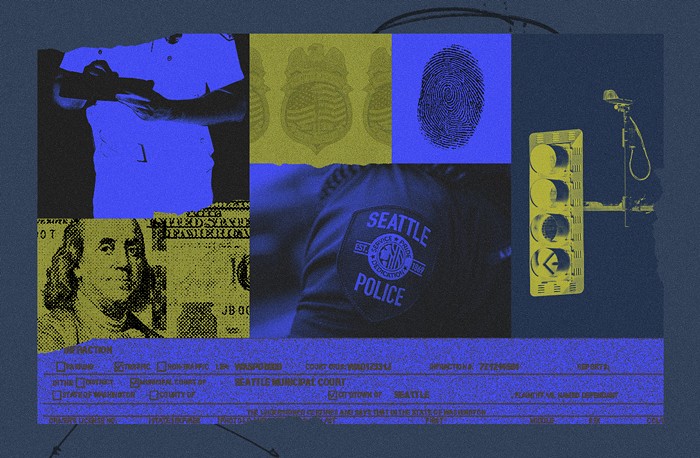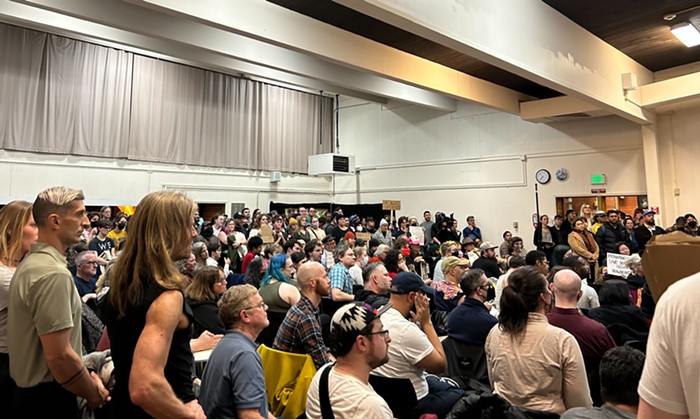If a human stumbles across a baby seal, one of the first things that person might notice about the baby seal is its eyes. "They're just these big, dark, limpid, black eyes holding yours," West Seattle resident Brenda Peterson tells me on a recent August evening. "You're just a goner, and people go, 'Oh, my god.'"
We're at an undisclosed location near a West Seattle waterfront so Peterson, a well-published nature writer who has lived in the area for 23 years, can show me where seal pups congregate. She agrees to do this on one condition: that I keep the location secret.
A seal pup's gaze tends to have a very intense effect on people, which has a lot to do with why I'm not allowed to write about where the animals haul ashore. Every year, some humans become convinced that those wide-eyed seal pups must be saved, so they intervene. These misguided rescue attempts often kill them.
Seal pups typically show up on the shores of southern Puget Sound between July and September. It's a natural part of the pupping season, when mother seals wean their pups on beaches and weaned pups learn to hunt on their own.
During the summer, some people see young seals on beaches without their mothers and mistakenly believe that they've been abandoned. They pick them up, feed them things that make them sick, and inadvertently scare away their mothers.
That's why eight years ago, Peterson cofounded Seal Sitters, a group of local volunteers trained by the National Oceanic and Atmospheric Administration (NOAA) that patrols Seattle beaches to find newborn seals before other humans (and dogs) get to them first. In late June, Seal Sitters found a seal pup with puncture wounds in Lincoln Park. In late July, the organization helped rescue a seal pup believed to have been plucked out of the water by boaters and dumped on a Poulsbo boat ramp.
In addition to being illegal, snatching seal pups jeopardizes this already fragile group.
"Every single day for a harbor seal pup is life and death because they are just teetering on that brink of survival," says Robin Lindsey, another founding member of Seal Sitters. Lindsey, who usually goes out at dawn to look for harbor seal pups, once found an open can of tuna fish in a spot where a seal pup had been resting.
"All those calories that they're spending to get away from people or dogs are calories they can't afford to lose," she says. "Just that act of scaring them [into the water] can put them over the edge where they can't make it."
Seals don't have tear ducts to drain tears from their eyes, which explains their drippy, vulnerable stare. Humans can't help but ascribe meaning to it. According to Scottish folklore, certain seal species even have the ability to shape-shift into human form. It was once believed that selkie folk, as the seal-people were called, could be taken as human lovers once they ditched their transmogrifying seal skins.
These days, humans may not be having sex with seal-people, but they're definitely doing some very questionable things to seals. When NOAA special agent Michael Killary moved to the West Coast from Alaska a year ago, he started hearing stories about humans herding baby seals into dog carriers, trying to stuff fish down their throats, feeding them baby formula, or even trying to make a seal pup sip Gatorade.
"It's always been a problem as far as I know from this area," Killary tells me over the phone. "You get people who see the seal pups on the beach and for whatever reason they feel the overwhelming urge to pick them up. I guess they feel like they're being abandoned, but that's not the case."
Seal mothers nurse their pups for several weeks after giving birth. Eventually, the mothers will leave their pups on the beach so they can hunt. After being weaned, the pups learn how to forage on their own. They lose precious fat while this happens, and lying on the beach conserves energy.
Often, human intervention will scare a mother seal away or force a pup to waste energy trying to escape, sometimes leading to its death. Harbor seals aren't considered endangered, Killary explains, so there aren't many resources to rehabilitate them when people pick them up and drop them off at a vet's office. "More than likely, the animal will just die, or it'll be put to sleep," Killary says. And it's still illegal for humans to harass seal pups under the federal Marine Mammal Protection Act. People are only allowed to observe seals from at least 100 yards away.
Human instinct commonly overrides the 100-yard rule. A year after Peterson and Lindsey started Seal Sitters, a Whidbey Island police officer who pulled over a woman for a traffic infraction discovered a seal pup in the backseat. The 5-day-old seal's joyride wasn't even its first bewildering encounter with humans. The Whidbey News-Times reported that earlier in the week, a couple had picked up the same newborn seal and kept it in a dinghy overnight. Wildlife rehabilitators named the pup Concho, but Concho survived only a month.
Jennifer Olson, the marine mammal stranding network coordinator at the Whale Museum in Friday Harbor, tells me she's heard of people trying to feed seal pups potato chips, and recently she even received a report of people pouring water over a seal pup they believed to be beached like a whale.
Dr. John Huckabee, a wildlife veterinarian, is not having a relaxing summer. His organization, the Progressive Animal Welfare Society (PAWS) wildlife facility in Lynnwood, is one of two facilities in Washington State certified to handle seal rehabilitation, and when I meet him, he's navigating a particularly busy schedule. People are bringing in baby birds and other wildlife at a greater frequency and earlier than they normally do, and it makes Huckabee wonder if that has something to do with migratory signals thrown off by the weird, warm weather. If the trend continues, PAWS will surpass all of its 2014 intakes by August of this year.
PAWS has treated a number of seal pups that have been tampered with by humans over the years. Today, they've also got number 2,800, the newborn seal pup left on the Poulsbo boat ramp, and number 2,200, the seal pup that Seal Sitters rescued from Lincoln Park in late June.
Years ago, Huckabee also treated a pup that someone scooped up and kept in a hotel bathtub for a couple of days. It came in dehydrated to the point of emaciation. "The seal pup was confiscated," Huckabee said.
Huckabee thinks that particular incident had more to do with curiosity than an attempt at being a Good Samaritan, but "the assumption that a pup is abandoned... if we can eliminate that perspective, that would be a good thing," he says. These acts tend to be "more kidnapping" than rescue, he adds.
Kidnapping is bad enough, but Peterson, the Seal Sitters cofounder, is worried about local seal pups for another reason, too. Many more weaned, emaciated pups have been showing up in West Seattle in recent years, which makes her wonder if something could be off in the Puget Sound ecosystem. Seals are an indicator species, which means they're often the first animals to show outward signs of distress when their environment is compromised.
But if seals aren't endangered, why does Seal Sitters spend so much energy protecting them? Peterson says she gets that question a lot. "My response to that is, why do we wait until an animal is endangered to have a healthy relationship with our ecosystem? That's like saying, 'You know, I'm not going to take care of my body until I get cancer.'"
If you see a seal pup on a Seattle beach, leave it alone and call Seal Sitters at 905-SEAL. If you see someone harassing a seal, call NOAA: 1-800-853-1964. ![]()


















